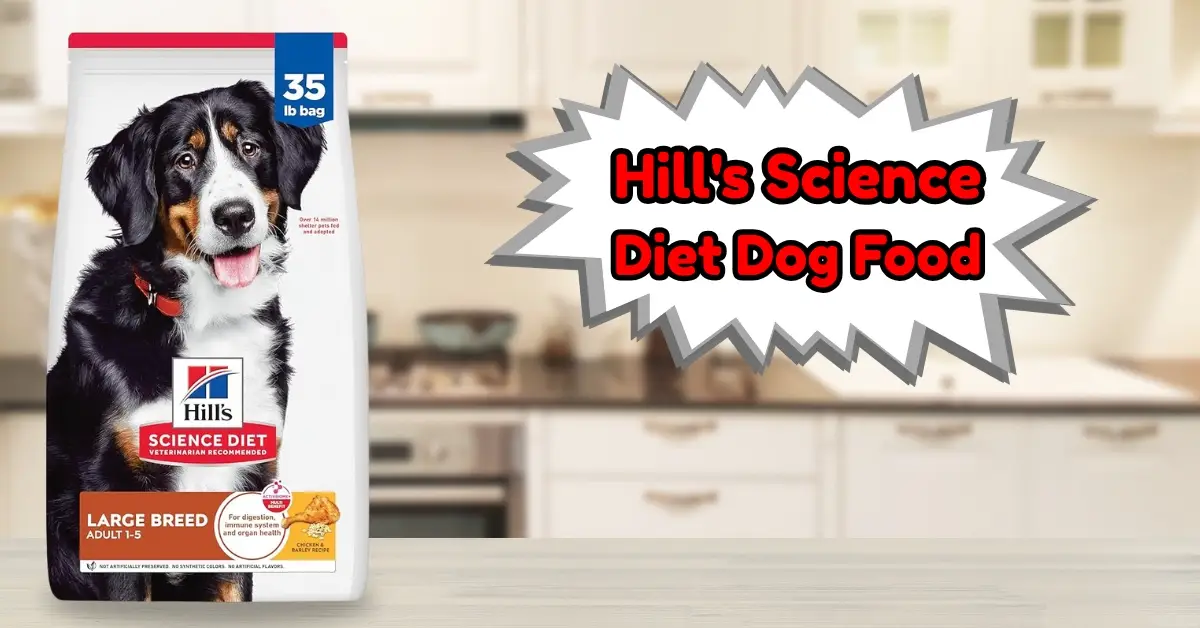Hill’s Science Large Breed Dog Food Review: I Trust to Nourish
It took me a while (and a few confused Google searches) to finally land on Hill’s Science Large Breed Dog Food for my own gentle giant—and I wish I had done it sooner. As a dog parent who’s tested everything from boutique blends to trendy grain-free formulas, I know how overwhelming the choices can get. What really stood out about Hill’s was how it catered specifically to large breeds like mine, not just with marketing buzzwords but with actual, noticeable results. In this article, I’ll walk you through why I chose it, how it compares to options like Hill’s Science Grain Free Dog Food and Hill’s Light Dog Food, and whether it’s really as good as they say. If you’re wondering “Is Hill’s Science Diet a good dog food?”—stick around. Let’s unpack this together.
Is Hill’s Science Large Breed Dog Food And Other Verity Worth It? My Honest Review-Guide
Short answer: Yes, Hill’s Science Large Breed Dog Food is a solid choice for large breed dogs—especially if you’re looking for targeted joint support, balanced nutrition, and vet-trusted ingredients.
When I first brought home my Labrador mix, I didn’t realize just how different large breed needs could be. Standard dog food just didn’t cut it—his energy dipped, his coat lost its shine, and his joints started feeling the strain by age three. That’s what sent me down the rabbit hole of options, and honestly? Hill’s Science Diet Large Breed Dog Food came out on top—not just in theory, but in actual, tail-wagging results.
What really impressed me was the formulation. It’s not just another bag of kibble with a fancy name. It’s packed with the good stuff: lean protein for strong muscles, glucosamine and chondroitin for joint health, and just the right fat content to keep weight in check without skimping on energy. If your pup is anything like mine, those little differences make a big impact.
And if you’re comparing it to Hill’s Science Light Dog Food or Hill’s Science Grain Free Dog Food, I’ve been there. I’ll walk you through what worked, what didn’t, and why the large breed formula made the most sense for my dog’s long-term health and happiness. Spoiler: it wasn’t about trends—it was about what truly worked.
Whether you’re switching from boutique brands, battling picky eating, or trying to support an aging dog’s joints, I’ve got you. Stick with me through this guide and you’ll know whether Hill’s is right for your dog—and your peace of mind.
Why I Chose Hill’s Science Diet for My Large Breed Dog: Discussion other options
When I adopted Max, my 90-pound Labrador mix, I quickly learned that large breed dogs have very different needs than smaller ones. It wasn’t just about more food—it was about the right food. Large breeds like Max grow fast, carry more weight on their joints, and can face health issues if their diet isn’t on point. By the time he turned three, he was slowing down on walks, his coat had lost that puppy shine, and his digestion was… well, inconsistent. I had a gut feeling his food wasn’t giving him what he really needed.
That’s when I started exploring better options—and Hill’s Science Diet kept popping up. I’ll admit, at first, I was skeptical. With so many brands out there shouting “natural,” “grain-free,” or “premium,” it’s hard to tell what’s marketing fluff and what actually works. I tried a few boutique blends that were all the rage on dog forums. Some helped a little, but none delivered real, lasting changes. What caught my eye about Hill’s was that it wasn’t chasing trends—it was focused on the science behind nutrition, specifically for large breeds.
I also liked that Hill’s wasn’t just throwing buzzwords at the bag. Their large breed formula included lean protein to help Max maintain muscle without putting on extra weight, plus glucosamine and chondroitin to support those hard-working hips and joints. That combination felt different—it felt intentional. And honestly, at that point, I was looking for something I could trust long-term, not just another temporary fix.
Still, I had my worries. Would Max actually eat it? Would it mess with his stomach during the switch? Was this going to be another overpriced experiment? But I trusted my instincts—and our vet’s recommendation. Hill’s had a reputation for transparency, clinical testing, and tailored nutrition. So, I made the switch, slowly mixing it into his meals over a week, and crossed my fingers.
Turns out, it was one of the best decisions I’ve made for Max. The changes didn’t happen overnight, but they were real—and noticeable. He started moving easier, eating with more enthusiasm, and even got a few compliments from the vet on his coat and muscle tone. Looking back, I just wish I’d found it sooner.
What Sets Hill’s Science Large Breed Dog Food Apart?
What made Hill’s Science Diet stand out to me was that it didn’t just say it was for large breeds—it was actually built around their real needs. When I read the nutrition label, it wasn’t just a list of ingredients; it was like a checklist of everything Max had been missing. Real chicken was the first ingredient, which meant he was getting quality protein to help maintain muscle without unnecessary fillers. The formula strikes that sweet spot too—about 20–23% protein and 10–12% fat—enough to keep Max active without tipping him into weight-gain territory.
Then there’s the joint support, which was a huge selling point for me. As Max got older, I noticed he’d slow down after longer walks. He’s not lazy—he’s just a big dog, and big dogs carry more weight on their joints. Hill’s includes glucosamine and chondroitin, which are basically like the WD-40 for creaky knees. After a few weeks on the food, he was getting up faster, walking farther, and even chasing the ball again instead of watching it roll by.
A lot of people ask how this compares to Hill’s Science Light Dog Food, and I get it—I tried that one too when Max started to pack on a few extra pounds. It’s lower in calories, which can be helpful if your dog is overweight or not super active. But for Max, it felt like it was missing something. His energy dropped a bit, and he didn’t seem as full after meals. The Large Breed formula was better suited for maintaining weight without making him feel like he was on a diet. It also offered better support for his joints, which Light doesn’t really focus on.
As for the grain-free version—yep, we tried that too. I got swept up in the whole “grain-free is better” wave, but it honestly didn’t do Max any favors. His digestion was off, and his coat lost a bit of that glossy shine. Turns out, most dogs don’t need to avoid grains unless they have a specific allergy, which is actually rare. When we switched back to the regular large breed formula with whole grains like brown rice, everything improved—especially his digestion.
What I’ve come to appreciate about Hill’s is that it isn’t trying to follow every trend—it’s sticking to evidence-based nutrition that’s made to work. For Max, it wasn’t just about finding something that looked good on paper. It was about finding food that supported his joints, kept his weight stable, and didn’t leave me second-guessing every ingredient. Hill’s Science Diet Large Breed did all of that—and that’s what sets it apart in a crowded field of flashy packaging and vague promises.
Real Results: My Dog’s Experience with Hill’s Science Large Breed and others option
I’ll be honest—when I switched Max to Hill’s Science Diet Large Breed, I wasn’t expecting miracles. I just wanted something that didn’t leave him bloated, bored, or itchy. But within a few weeks, I started noticing changes that felt real. His coat went from dull and patchy to soft and shiny, like he’d just had a spa day. His digestion also became much more predictable—no more upset stomachs or surprise accidents. The formula seemed to settle things down and keep them moving the way they should.
His energy level is where I saw the biggest difference. Before the switch, Max was slowing down on our walks. Not drastically, but enough that I wondered if it was just aging catching up. But after a few weeks on Hill’s, it was like he got a second wind. He started trotting ahead of me again, chasing squirrels he used to ignore, and bringing me toys like we were back in puppy mode. It was subtle, but it was real—like he just felt better in his own skin.
That’s not to say everything was perfect from day one. The transition took a little patience. Max is notoriously picky—he once turned down freshly cooked chicken—so new kibble always comes with a side of side-eye. I mixed the Hill’s food in with his old kibble over about a week, gradually increasing the ratio. At first, he sniffed and walked away a couple of times. But by day five, he was all in. And the best part? No stomach issues during the switch. That alone felt like a win.
A few months in, we visited the vet for a routine check-up—and even she noticed the difference. His weight was right where it should be, his coat got compliments, and his joints seemed more flexible. She mentioned his muscle tone had improved too, which was a huge relief. That kind of feedback—from someone who sees dozens of dogs a week—meant a lot. It confirmed that I wasn’t just seeing what I wanted to see.
Looking back, Hill’s didn’t just improve Max’s health—it gave me peace of mind. I wasn’t guessing anymore. I could see and feel the results in how he looked, moved, and acted. For a big dog with big needs, that kind of confidence in a food brand is priceless.
Comparing Hill’s Science Diet Options for Large Dogs And Other Verity
Hill’s Science Diet Large Breed Adult vs. Large Breed Puppy
When Max was a puppy, I thought any dog food would do. I was wrong. Big puppies like him grow fast, and their bones need extra care. Hill’s Large Breed Puppy food gives them what they need—like DHA from fish oil for brain health and the right amount of calcium for steady bone growth.
Once Max turned about 15 months, we switched to the adult version. The formula changes a bit. The focus is more on keeping muscles strong and joints healthy. This formula still provides good protein and less fat to help control weight. Additionally, glucosamine and chondroitin are included to support joints as dogs get older. That change made a big difference in Max’s energy and movement.
Hill’s Science Diet vs. Hill’s Science Plan
Let’s clear up the name thing. I used to wonder—what’s the deal with “Science Diet” and “Science Plan”? Here’s the simple answer: they’re the same food. The name just depends on where you live. In the U.S., it’s called Science Diet. In places like Europe, it’s sold as Science Plan.
Same food, same ingredients, same science—just different labels. Once I found that out, shopping got a lot less confusing.
Specialty Diets: Metabolic, KD, and Light Formulas
When Max gained a few pounds, I tried Hill’s Science Diet Light. It has fewer calories and less fat but still fills him up. It helped him slim down without feeling hungry. He stayed happy, and I felt good about it.
A friend of mine used Hill’s Metabolic formula for her dog. That one needs a vet prescription. It’s made to help dogs lose weight in a healthy way. It worked well for her pup and helped him get back to a healthy shape.
There’s also the Hill’s KD formula. It’s for dogs with kidney problems. It lowers phosphorus and has just the right protein. You need a vet’s OK for this one too, but it can really help dogs with kidney trouble.
Each of these foods has a special job. They’re not one-size-fits-all. Always ask your vet before trying one. What worked for Max might not work for your dog—but it’s great to have options.
Addressing Common Concerns and Recalls
Let’s be real—when you’re feeding your dog the same food every day, safety matters. I remember hearing about a Hill’s recall back in 2019 and feeling that pit in my stomach. It was due to high levels of vitamin D in some canned recipes. Luckily, it didn’t affect the dry large breed formula I use, but it still gave me pause.
What stood out to me, though, was how Hill handled it. They didn’t try to sweep it under the rug. They posted a full recall notice, contacted vets, and offered refunds. It wasn’t just lip service—they took responsibility fast and were upfront about what happened.
That kind of transparency is rare in the pet food world. I appreciated that they didn’t dodge the issue or blame suppliers. They owned it. That actually made me trust them more, not less.
Of course, I didn’t just take their word for it. I talked to our vet, who told me Hill’s is still one of the most research-backed brands out there. Their food is made in the U.S., follows strict safety checks, and is tested in real feeding trials—not just lab formulas.
I’ve kept Max on Hill’s since then because I’ve seen the difference it makes. His coat is better, his joints move more easily, and vet visits have gone smoother. No brand is perfect, but I care more about how a company acts when things go wrong—and Hill’s showed me they care, too.
So yes, there was a recall. But for me, it’s how they handled it—and how Max is doing now—that sealed my trust in Hill’s.
Is Hill’s Science Diet a Good Dog Food? The Verdict
Yes, Hill’s Science Diet is a good dog food—especially for large breeds needing targeted joint support, muscle maintenance, and balanced energy.
Now, let’s break that down.
When I first started researching dog food, I felt like I was decoding a secret language. “High-protein,” “grain-free,” “all-natural”—it all sounded promising, but none of it told me how my dog would actually feel. What finally cut through the noise was something simple: results. Hill’s wasn’t just full of nice words—it delivered noticeable changes in Max’s health.
It’s a vet-recommended brand with research to back it up. That alone gave me peace of mind. Our vet explained that Hill’s formulas are designed with large breeds in mind—less guesswork, more science. And it shows. Max’s joints, coat, weight, and digestion all improved after switching.
But let’s be honest—it’s not the perfect choice for every dog.
Hill’s Science Diet is best for large breed dogs who need joint care, controlled calories, and steady energy—not those with rare grain allergies or ultra-sensitive stomachs. If your pup truly needs a grain-free diet due to diagnosed allergies, Hill’s grain-inclusive formulas might not be the right fit. Also, picky eaters might need time to adjust. Max was hesitant at first, but it didn’t take long once we mixed things gradually.
I did my homework before settling on Hill’s. After some research, I discovered that their products had excellent reviews. The more I learned, the more confident I felt about my choice:
- Royal Canin: Great but more expensive. Max didn’t love the taste.
- Blue Buffalo: Trendy and natural, but gave him digestive issues.
- Purina Pro Plan: Solid option, but Hill’s had better joint support for Max’s needs.
Hill’s worked—and kept working, which is why I stayed with it. The results were consistent, giving me confidence. That’s what mattered most. Max looked better, moved better, and, honestly, just seemed happier. That kind of proof is hard to ignore.
At the end of the day, we all want to feed our dogs something that makes them feel their best—without the stress of second-guessing every ingredient. For me, Hill’s Science Diet took away that guesswork. It became something I could rely on, and Max could thrive on.
Bottom line? If you’ve got a large breed dog and want food that supports their joints, keeps their weight in check, and is backed by real science—Hill’s Science Diet is 100% worth considering.
FAQs on Hill’s Science Large Breed Dog Food?
Is Hill’s Science Diet good dog food for large breeds?
Yes, it is. Hill’s Science Diet is great for big dogs. It helps with joints and gives steady energy.My dog Max is 90 pounds. Since switching to this food, he moves better and his coat shines. The vet says it’s a smart choice. It has protein, fat, and extras that big dogs need.
What is the difference between Science Diet and Science Plan?
They are the same food.“Science Diet” is used in the U.S.; “Science Plan” is used in the UK and other places. They are both made by Hill’s and have the same recipe. I was confused at first too!
Can I feed this to a medium or small breed dog?
You can, but it’s not the best.Big dog food has more of some things like calcium and less fat. It helps big dogs stay healthy. But it can be too much or not enough for small dogs.
I gave some to Max’s cousin (a 30-pound spaniel), and he got slow and tired. So it’s best to use food made for your dog’s size.
Is there a grain-free option for large breed dogs?
Yes, but it may not be better.I tried the grain-free food for Max. He had tummy trouble and his coat looked dull. Most dogs do fine with grains like brown rice. Only skip grains if a vet says so.
What age is considered “adult” for large breed formulas?
Around 12 to 18 months old.Max switched at 15 months. That’s when he stopped growing fast. Big puppies need extra care. But when they’re full size, adult food keeps them from gaining too much weight. Ask your vet to help pick the right time.
How often should I switch dog food brands?
Only when you need to.I used to think dogs like change. But most dogs do better with the same food. If your dog is doing well, don’t switch. I’ve fed Max Hill’s for two years. He’s still doing great. If you do change foods, go slow. Mix in the new food over a few days. That way, your dog won’t get sick.
Final Thoughts: Should You Try Hill’s Science Large Breed Dog Food?
If you’ve made it this far, you’re clearly a thoughtful, committed dog parent—and that’s half the battle when it comes to choosing the right food.
Hill’s Science Diet Large Breed isn’t flashy or trendy. It’s not promising magical transformations. But what it does offer is something far more valuable: consistency, science-backed nutrition, and real results.
For my dog Max, it meant fewer joint issues, better digestion, and a coat that turned heads at the dog park. For me, it meant peace of mind—and fewer emergency trips to the vet.
Here’s who I’d recommend it for:
Large breed dogs that need joint support and steady energy Dogs with weight concerns that don’t require prescription diets Owners who want science-backed nutrition without the guesswork Pups who struggled with boutique or grain-free diets
Of course, no food is perfect for every pup. But if your big dog has big needs—and you’re tired of the trial-and-error routine—Hill’s Science Diet Large Breed might be the simple, solid solution you’ve been looking for.
Final word? I wish I had found it sooner. Max is thriving, and that’s the only review that really matters.

Taslima Akter Sumaiya is a passionate pet mom and founder of PetFoodHubing.com. With real-life experience and insights inspired by USDA-ARS experts like Dr. Jitender P. Dubey, she writes honest, research-backed reviews to help dog and cat parents choose the best food. Trust her to simplify pet nutrition—with love and science. Read More…












